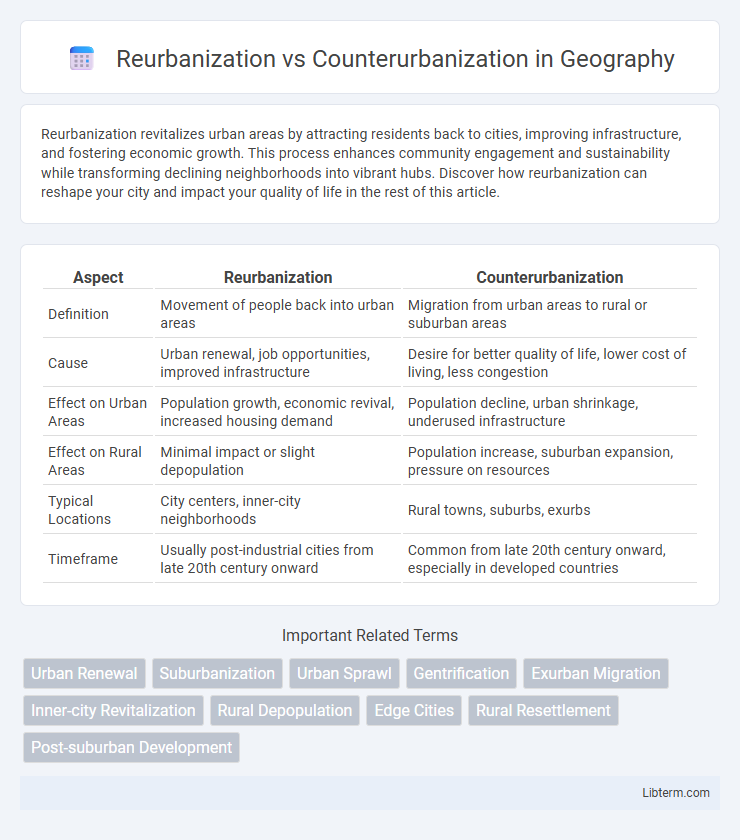Reurbanization revitalizes urban areas by attracting residents back to cities, improving infrastructure, and fostering economic growth. This process enhances community engagement and sustainability while transforming declining neighborhoods into vibrant hubs. Discover how reurbanization can reshape your city and impact your quality of life in the rest of this article.
Table of Comparison
| Aspect | Reurbanization | Counterurbanization |
|---|---|---|
| Definition | Movement of people back into urban areas | Migration from urban areas to rural or suburban areas |
| Cause | Urban renewal, job opportunities, improved infrastructure | Desire for better quality of life, lower cost of living, less congestion |
| Effect on Urban Areas | Population growth, economic revival, increased housing demand | Population decline, urban shrinkage, underused infrastructure |
| Effect on Rural Areas | Minimal impact or slight depopulation | Population increase, suburban expansion, pressure on resources |
| Typical Locations | City centers, inner-city neighborhoods | Rural towns, suburbs, exurbs |
| Timeframe | Usually post-industrial cities from late 20th century onward | Common from late 20th century onward, especially in developed countries |
Understanding Reurbanization: Definition and Drivers
Reurbanization refers to the process of population growth and urban renewal within city centers, often reversing previous trends of suburbanization and urban decline. Key drivers include economic revitalization, improved infrastructure, cultural amenities, and policies promoting sustainable urban living. This phenomenon is propelled by increased demand for accessible housing, employment opportunities, and enhanced quality of life in metropolitan cores.
Exploring Counterurbanization: Meaning and Key Factors
Counterurbanization refers to the demographic and social process where people move from urban areas to rural regions, driven by factors such as desire for better quality of life, lower living costs, and reduced pollution. Key elements influencing this trend include technological advancements enabling remote work, increased environmental awareness, and expansion of transport infrastructure connecting rural with urban centers. This movement often leads to economic revitalization of rural areas while impacting urban population density and housing markets.
Historical Context: Urbanization Trends Through the Decades
Reurbanization emerged in the late 20th century as many cities experienced population growth and revitalization following decades of suburban expansion. Counterurbanization, prominent from the 1960s to the 1980s, described the migration from urban centers to rural or suburban areas driven by factors like industrial decline and desire for improved quality of life. Both trends reflect shifting socio-economic forces shaping urban demographics and development patterns over time.
Causes Behind Reurbanization Movements
Reurbanization is primarily driven by economic revitalization, improved urban infrastructure, and increased cultural amenities attracting residents back to city centers. Factors such as urban renewal projects, job opportunities in service and tech sectors, and enhanced public transportation contribute significantly to this trend. Changing lifestyle preferences among young professionals and retirees also play a crucial role in motivating population shifts towards urban cores.
Factors Fueling Counterurbanization Shifts
Counterurbanization is driven by factors such as the desire for improved quality of life, lower housing costs, and less congestion in rural or suburban areas. Advancements in remote work technology and increased car ownership enable people to live farther from urban centers while maintaining employment. Environmental concerns and the search for greener, more sustainable living environments also contribute significantly to counterurbanization trends.
Demographic Impacts: Who Moves and Why?
Reurbanization attracts younger professionals and creatives seeking job opportunities and urban amenities, leading to demographic rejuvenation and increased population density in city centers. Counterurbanization typically involves families and retirees moving to suburban or rural areas for affordable housing, better quality of life, and reduced congestion, resulting in population decline and aging in urban cores. These migration patterns reshape age structures, socioeconomic compositions, and demand for services across regions.
Economic Implications: Opportunities and Challenges
Reurbanization revitalizes urban centers by attracting investments, boosting local businesses, and increasing job opportunities through infrastructure redevelopment and urban renewal projects. Counterurbanization shifts economic activities toward suburban and rural areas, fostering growth in smaller markets but often challenging public service funding and infrastructure capacity. Both trends impact regional economies by redistributing resources, affecting real estate markets, and requiring balanced policy strategies to manage growth and sustainability.
Social and Environmental Consequences
Reurbanization drives increased social diversity and economic revitalization in urban centers, but it can also cause gentrification and displacement of low-income communities. Counterurbanization leads to population growth in rural and suburban areas, reducing urban congestion and pollution but often resulting in the loss of agricultural land and strain on local resources. Both phenomena significantly impact social equity and environmental sustainability, influencing housing affordability, infrastructure demands, and ecosystem preservation.
Urban and Rural Policy Responses
Urban policy responses to reurbanization prioritize revitalizing infrastructure, promoting affordable housing, and encouraging sustainable development to attract residents back to city centers. Rural policy approaches addressing counterurbanization emphasize improving local services, enhancing connectivity, and supporting economic diversification to accommodate growing populations moving from urban to rural areas. Coordinated strategies balancing investment and resource allocation in both urban and rural regions ensure effective management of demographic shifts and regional development.
Future Outlook: Balancing Urban and Rural Growth
Reurbanization and counterurbanization trends will shape future urban and rural growth by promoting balanced development strategies that address housing demand, infrastructure expansion, and environmental sustainability. Urban planners and policymakers must integrate smart city technologies and green spaces to revitalize city centers while supporting rural economies through improved connectivity and services. Effective collaboration between government agencies and community stakeholders is essential to ensure equitable resource distribution and resilient, adaptive growth patterns.
Reurbanization Infographic

 libterm.com
libterm.com